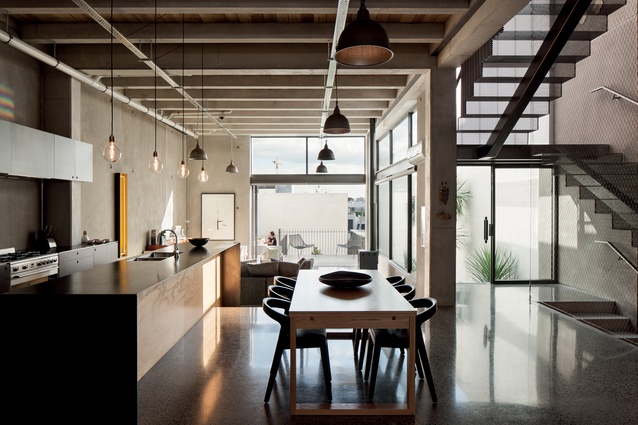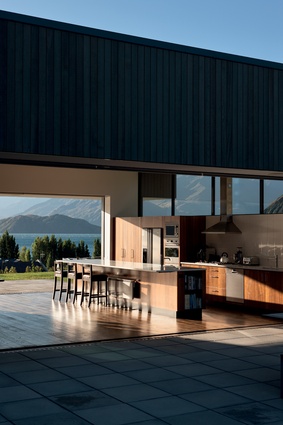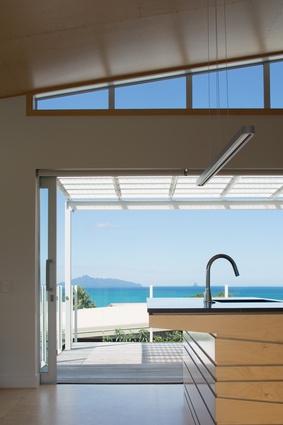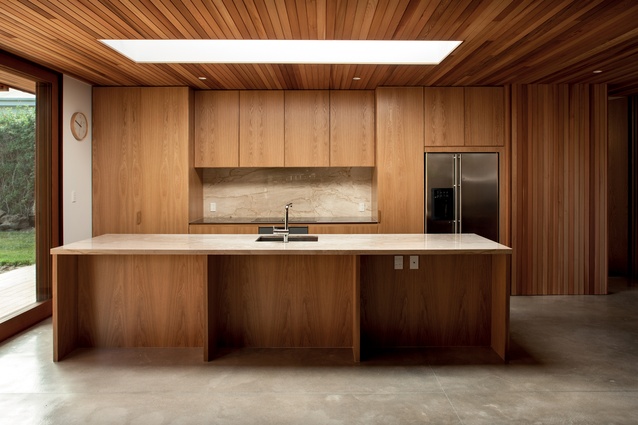The Kiwi kitchen
The kitchen typically contains the most complex set of design considerations of any room in the house, so we asked a few Kiwi architects and design professionals for some sage advice.
The kitchen is nearly always the most complicated area of a house to design because it is not only a food preparation area, with the multitude of machines, gadgets and appliances we’ve come to expect, but it also needs to accommodate all the extra activities we now do in the kitchen throughout the day and night, from homework to working to socialising.
So what are the key design elements we need to think about when designing a new kitchen? “Always consider the kitchen design in the context of the whole house and your lifestyle,” suggests architect Natasha Markham, of Auckland practice MAUD.
“The circulation of the kitchen needs to flow into the rest of the house, and the materials used need to complement each other too,” states Wanaka-based architect Rafe Maclean. “There needs to be a unity of ideas, while aesthetics and durability are key elements that help connect the architecture,” he adds.
Gerald Parsonson, of Parsonson Architects in Wellington, agrees: “The kitchen is integral to the whole flavour of the house. Even if you’re using off-the-shelf elements and you don’t have a large budget, you can include a level of craft or intrigue – sometimes in subtle ways, such as a great colour painted onto MDF – to create surprises for people.”
“Architects work hard to develop their knowledge of what the owner is wanting. Some people want everything in the kitchen ‘out and handy’ to use, while others want things tidied away and obsessively neat. Some want a scullery. Some want their dishwasher to the left or right – everyone has their own way of doing things.”
But kitchen design typically starts with the classic ‘triangle concept’ of sink/cooker/fridge, and Parsonson suggests that the key to this is to get the spacing between each element just right. While a lot of chefs and good cooks can efficiently whip up a storm in a tiny kitchen, the best kitchen design really depends on the character of the owners. “People have different styles of working in a kitchen; some move from space to space and clean up afterwards, while others efficiently clear up as they go.”
Rafe Maclean generally approaches kitchen design by firstly establishing areas for food storage (pantry to fridge); secondly, food preparation areas (including ovens); thirdly, food service (such as tool storage and crockery); and fourthly, washing up. “It pays to consider ‘what do you eat and what do you want to cook?’ Do you want the cooking and washing up exposed to the dining area? Do you want the kitchen integrated into the rest of the house?”
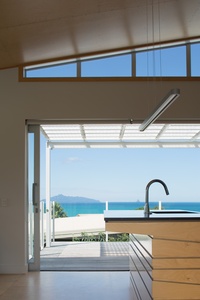
He also suggests that you think about different scenarios and movements within the kitchen, such as making coffee and toast in the morning, and whether you want guests to come into the kitchen while you’re cooking and, if so, where should they sit? “It’s a fun process to go through with the client as they often haven’t thought about these details. But it’s really important, especially for families with young children, to think about how the kitchen will be used in the future – as children become teenagers, for example. Will you need a bigger fridge?”
In the case of the Langs Beach House, Natasha Markham discovered that her client didn’t cook much for herself; however, she loves to entertain people. “She wanted a communal kitchen experience so friends and family can cook meals together, but we also needed to take into account that the house is occupied just by her most of the time. We are always thinking about spaces that can be flexible in their use.”
Kitchen trends in 2017 are as interesting as ever. Rachel Louie, executive director at Jones Family Investments, which owns Kitchen Things, suggests that as people are becoming more time poor but more aware of healthy, quality cooking methods, they need a lot more from their appliances. Equipment adapted from chefs’ kitchens, such as sous vide cooking, blast chillers and combi-steam cooking, ensure that, with little preparation, a home-cooked meal can be prepared in less than half an hour.
In terms of aesthetics, Scandinavian-designed appliances – characterised by clean lines and natural, earthy tones – are strong, while some small appliances are now available in a wide variety of colours. Beautiful jewel tones are currently trending colours, although Louie recommends avoiding overwhelming the kitchen space by “using small pops of jewel and metallic tones to enhance an overall kitchen look”.
The mixing up of metals is another appliance trend. “Homeowners are increasingly going for appliances and accessories with different finishes – such as gold, copper or pewter – for an eclectic, one-of-a-kind space,” explains Louie.
One example is Smeg’s new appliance series Dolce Stil Novo, which is coming to New Zealand towards the end of 2017 and features pure black steel and glass elements, mixed with copper or stainless steel details.
“Another big trend this year is the smart use of space and the seamless integration of appliances into their surroundings,” adds Louie. This includes open shelving, integrated cooktops and disappearing elements to create a sense of flow and cohesion within the kitchen. In the future, it seems that kitchens will be further integrated into other areas of the house.
“Kitchens and dining areas have already become blurred as very few people want to separate these spaces in terms of everyday living,” explains Markham. “More and more, kitchens will bleed into other areas, so extra spaces can be colonised as needed.”
Increasingly, our kitchens will need to become more versatile and more efficient – to save on space and for sustainability reasons as well. Looking ahead, perhaps a robot chef will take care of the cooking, or maybe our kitchens will be tiny and we’ll all be eating out cheaply each night but, for now, there are plenty of useful design tips to designing beautiful and useful kitchens.
ROOM WITH A VIEW
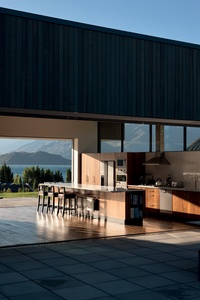
“This holiday house in Wanaka can accommodate ten people at once. The key to maximising views from any kitchen is to establish which points have a view and which don’t. We think about where the sun will hit the bench surfaces and make sure there is shade. Sometimes its more important to see the views as you turn sideways. This house overlooks the mountains and lake, but it can also be a windy site, so we designed it to open up fully on two aspects but each side can also be closed down. The kitchen serves both ways, addressing people in the courtyard as well as on the front patio, although it is biased to the courtyard which is used more often. There is a neighbour on the north-facing side, so the sink is below the window to maintain privacy while still letting light in.”
— Rafe Maclean, Rafe Maclean Architects
COOK’S KITCHEN

“We designed this kitchen for Adie McClelland and her husband Matthew’s coastal cottage in Mangakuri in Hawke’s Bay. Adie has written cookbooks and gives cooking classes, so she wanted everything to hand. The couple spends part of the year in Greece, so they enjoy this kind of raw character. A flashy kitchen wouldn’t have seemed right at Mangakuri, which is surrounded by rugged farmland and coast; they wanted a more relaxed feel. The joinery uses natural timber, plywood and hand-painted MDF – in keeping with the rest of the house. Adie has her chopping block in the middle of the kitchen and, because she likes cooking on gas, we included a large stainless steel extractor with the pipework exposed.”
— Gerald Parsonson, Parsonson Architects
WOOD ON WOOD
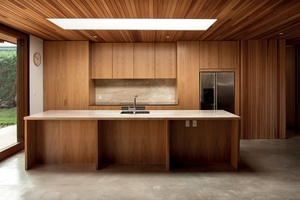
“This is an addition to an existing house, and the kitchen is part of a larger dining/living area. Even though there is a lot of timber going on here, I think that the difference in texture between the ceiling and the cabinetry, for example, is enough to create a sense of variety and balance. Although it’s not obvious from the photo, the timber is offset by crisp white walls, and the darker tones of the wood are alleviated by the large skylight over the kitchen island. Because timber is a natural product, and there can be a lot of life and pattern inherent in the material itself, I like to use it in simple compositions that are cleanly detailed.”
— Sam Williams, Cook Sargisson Pirie & Williams Architects
ALL-IN-ONE
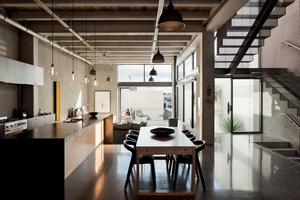
“This large, open-plan kitchen and dining space incorporates a number of functions. The client gave us a basic brief to utilise simple materials in keeping with the raw industrial feel of the place, with lots of storage and a large bench for people to gather around.
Budget is one of the main considerations when designing a kitchen as it will dictate the kind of materials and finishes that can be used. Also, how do you like to use the kitchen? Is it a space where you would like to have some separation, or is it a space that you would like people to gravitate to and be part of the main living space.”
— Andrea Bell and Andrew Kissell, bell & co architecture

